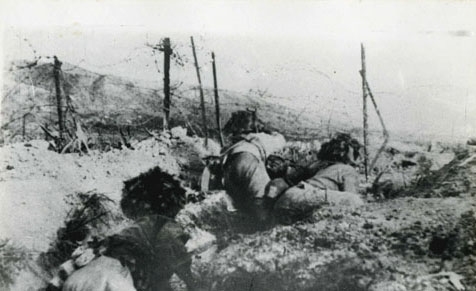On April 1, 1954, the enemy launched three defensive attacks and all of them were driven away by troops from Regiment 102. Hundreds of enemy paratroopers were eliminated from the combat, one tank was damaged by Vietnamese gunners.
At night on April 1, Regiment 102 teamed up with Regiment 174 and launched the third offensive operation on the underground bunker but still failed. In the following days, each side could hold half of the fortification on Hill A1. Vietnamese troops were in the Eastern half while the Western half was under the enemy’s control. The Hill A1 area seemed to be a mountain of debris.
    |
 |
|
Our troops cut barbed wire, dug trenches, and penetrate deep into the enemy fortifications. (A filed photo) |
In that fierce and difficult situation, there appeared many examples of courage and smartness, profound and flexible command, such as regiment Commanding Officer Hung Sinh, battalion Second-in-Command officers Ngo The Luong and Le Son. They had many times opened fire from submachine guns and threw hand grenades at enemy troops. Despite being hungry for many days, liaison squad leader Bui Minh Duc and signal soldier Chu Van Mui did not forget their missions. When caught in the middle of the enemy siege, Chu Van Mui calmly used his intercom to instruct artillery troops to fire at enemy troops to protect wounded soldiers. The tug of war between our troops and the enemy in this area continued until April 4.
While Regiment 102 received the task of maneuvering to the East to replace a unit to continue attacking Hill A1, Regiment 36 was assigned to attack fortification 106 in the area to the west of Muong Thanh Airbase.
At night of April 1, our troops secretly moved along the trenches, got close to the first line of the entrenchment, destroyed enemy gun emplacements, and then promptly entered the fortification, suddenly opened fire, killing the enemy in 30 minutes. The offensive at fortification 106 could be considered the opening battle in which our troops started using siege and encroaching warfare.
    |
 |
|
Tourists visit the light tank which was burned by our troops’ Bazooka on the early morning of April 1, 1954. |
Implementing the strategy “Steady combat, steady advance,” our soldiers created the siege and encroaching warfare - a strategy to attack the enemy in its entrenched fortifications by encircling, attacking, decimating and destroying all the enemies.
The siege and encroaching warfare started with the battles at fortifications 106 and 105 and was perfected in the battle at fortification 206. In the battle at fortification 206, our soldiers built a battlefield to approach the enemy fortification, sniped and attacked enemy troops who were trying to destroy our battlefield. Our troops were also divided into small detachments to attack and besiege the enemy, making them stressed and exhausted before launching a final attack to conquer the fortification. This was a great development of our military tactics during the Dien Bien Phu Campaign.
Translated by Mai Huong